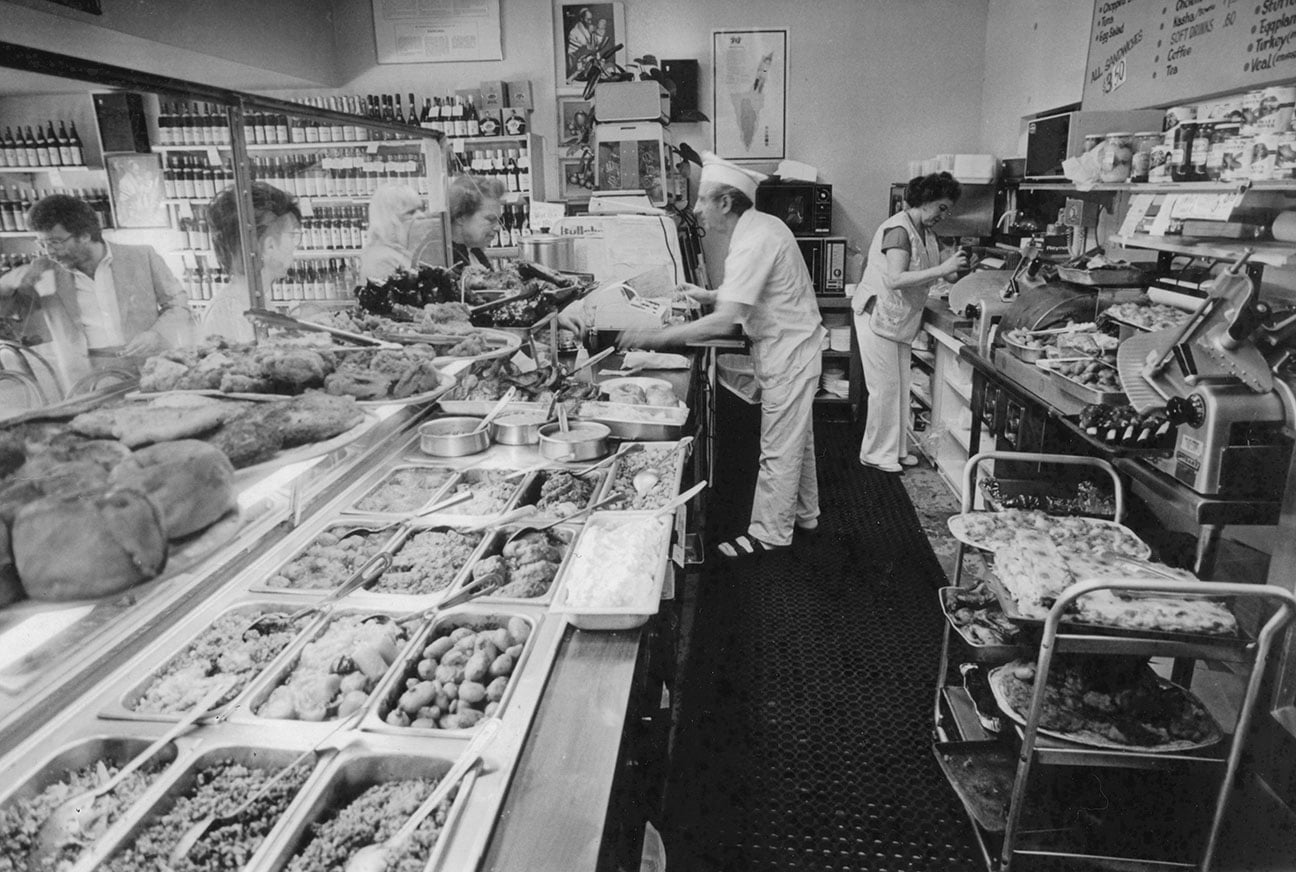 Rena and Harry Drexler at Drexler’s Deli, North Hollywood, CA, c.1970s. Private collection
Rena and Harry Drexler at Drexler’s Deli, North Hollywood, CA, c.1970s. Private collection Everyone has a deli favorite: chicken matzah ball soup, pastrami or corned beef on rye with lots of mustard, bagels and lox. But the deli is so much more than the food itself.
In its new exhibition, “I’ll Have What She’s Having: The Jewish Deli,” the Skirball Cultural Center celebrates the delicatessen’s rich history, culture and legacy.
Co-curated by Skirball curators Cate Thurston and Laura Mart, with renowned writer and producer Lara Rabinovitch, a specialist in immigrant food cultures, “I’ll Have What She’s Having: The Jewish Deli” is joyous, communal and nostalgic.
“The exhibition explores how Jewish immigrants imported and adapted traditions to create a uniquely American restaurant,” Rabinovitch, whose PhD from NYU was about pastrami, told the Journal. “More than a place to get a meal, the Jewish deli is a community centered in food that demonstrates the important contributions immigrants have made to American society.”
And with a title like, “I’ll Have What She’s Having,” fun is clearly on the menu. The exhibition’s title comes from the movie “When Harry Met Sally.” It’s the hilarious line that concludes the memorable scene in New York’s Katz’s Delicatessen.
“’I’ll Have What She’s Having’ is about sharing a meal, enjoying something,” Thurston said. “It’s an inside joke, if you get it, and it’s an offering to build community and share food, if you’re not familiar.”
Mart and Thurston started developing the idea for the deli exhibition in 2017. Skirball is always looking at ways to tell stories about immigration that highlight how the United States is a pluralistic society, Mart said. The duo did a research trip in 2019, where they traveled, looking through archives for unexpected objects to tell these deeper histories and eating at delis across the country.
“We have contextualized these objects so that visitors can dive deeper into this history and the nostalgia and learn more,” Mart said. “Education is a big part of museum practice, and so we’re taking this opportunity to educate our visitors and the general public about Jewish history, food history and American history.”
“Education is a big part of museum practice, and so we’re taking this opportunity to educate our visitors and the general public about Jewish history, food history and American history.” – Laura Mart
The exhibition is organized into sections, thematic content modules that are like mini-exhibits.
“Food of Immigration” features artifacts from the Skirball Museum collection. At the turn of the century, Jews brought candlesticks, knives, suitcases, passports and textiles, along with their hopes, dreams and foodways. “The Food” features a colorful display of food imagery and props, as well as helpful definitions of food terms and fun food facts. “Mid-Century Heyday” focuses on the period of the unparalleled growth for the American Jewish community and its delis in the mid-20th Century, and features deli and restaurant menus and matchbooks from that time.
“No Substitutions” looks at the original characters, the people who own and work at delis. On display are vintage uniforms, implements from classic LA delis Factor’s, Canter’s, and Nate n’ Al’s, along with photographs and video interviews.
“No Substitutions” is one of Mart’s favorite storytelling moments in the show.
“We have stories from some deli owners and workers, told through original interviews that we conducted, as well as some archival footage,” she said.
Visitors are also invited to write down their go-to deli food or favorite deli memory and pin it up on a restaurant-style order line.
“Who’s at the Table?” reflects on how immigrant-owned delis and their foods were woven into the urban American landscape, and embraced by Jews and non-Jews alike. It also reveals how ideas of Jewishness in the United States during the 20th Century were rooted in Central and Eastern European Ashkenazi Jewish culture.
“Survivor Communities” displays the stunning original neon sign that brightened the entrance to Drexler’s Deli in North Hollywood, which was owned and operated by Rena Drexler, a survivor of Auschwitz, and her husband, Harry. Delis were a lifeline for many of the 400,000 Holocaust survivors and refugees, who rebuilt their lives in the United States.
“Pop Culture on Rye” explores why the deli continues to be used by Jewish creatives as a setting and a character in film and television. It features artifacts and photographs that explore deli nightlife, as well as a viewing station of deli footage in TV (“Curb Your Enthusiasm,” “Seinfeld,” “The Marvelous Mrs. Maisel”) and film (“When Harry Met Sally,” “At War with the Army”).
“One of the most surprising finds is the image of Elvis Presley with deli employee Joe Guss at Glassman’s Deli and Market, Los Angeles, CA, 1969 (from the Bonar Family Collection),” Rabinovitch said. “Glassman’s Deli and Market, open from around 1930 to 1979, sold Jewish specialty foods. It was located on Western Avenue in Hollywood, next to an adult theater. Some scenes from Elvis Presley’s last movie, “Change of Habit” (1969), co-starring Mary Tyler Moore and Ed Asner, were filmed in Glassman’s Deli and Market.”
“Shifting Landscapes,” which contains menus from eateries around the country, reflects on how delis have adapted to change over the years, whether that meant revising their menus, moving locations or closing due to health trends, real estate prices, family issues or business woes. This includes influences from Sephardic and Israeli Jewish cuisine, focusing on justice in running their businesses and of course adapting to the COVID-19 pandemic.
Deli is a food of resilience, Thurston said.
“Even though the physical number of delis has dwindled since its mid-century heyday, it is a foodway and a cuisine that has just as much resonance now as it did in the past. It is something that brings people together and we find great joy and purpose in that resilience. I think that thread is really visible in our survivor stories, where we feature the stories of Holocaust survivors and refugees, both locally and nationally, and the delis they started and the communities they built.”
Both of the Skirball cafes have cooked up some specials specifically for this exhibition. Find cheese blintzes, potato knishes, tuna melts, New York cheesecake and more at Zeidler’s Café. Judy’s Deli’s offerings include hot pastrami and corned beef sandwiches, matzah ball soup, rugelach and black and white cookies.
“Our shop will also be featuring a selection of classic deli products like mustard and sauerkraut [and] Dr. Browns, so people will be able to scratch the food itch,” Mart said.
“I’ll Have What She’s Having: The Jewish Deli” will be on view at the Skirball through September 4, 2022. Watch for a variety of exhibition-related programming, including an outdoor screening this summer of “When Harry Met Sally.”
The Skirball is located at 2701 N. Sepulveda Blvd. in Los Angeles. Advance timed-entry reservations are required. For general information, call 310.440.4500 or visit skirball.org.























 More news and opinions than at a Shabbat dinner, right in your inbox.
More news and opinions than at a Shabbat dinner, right in your inbox.